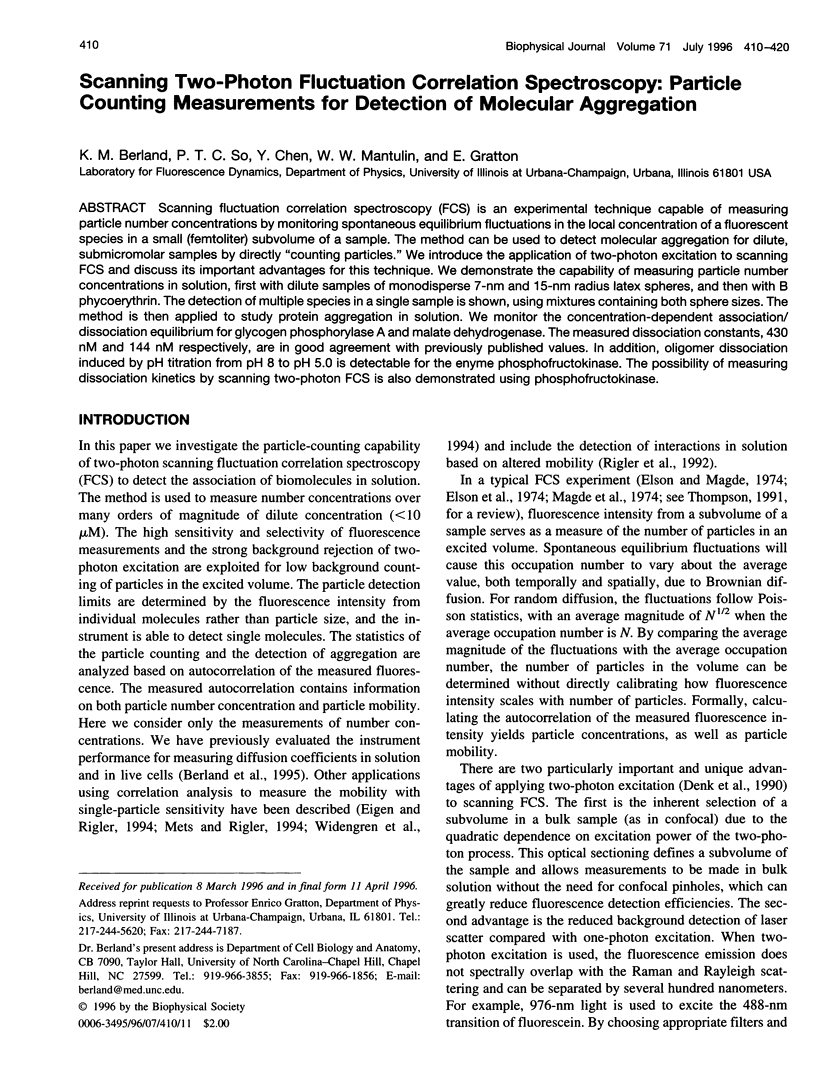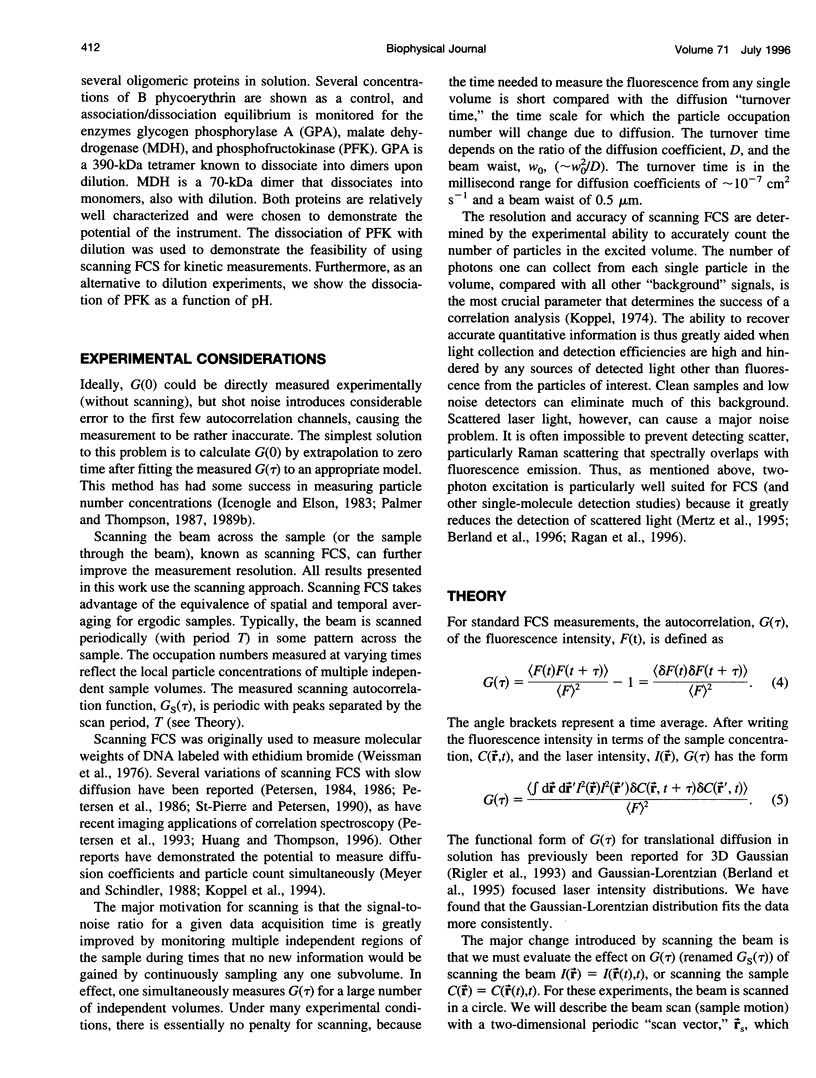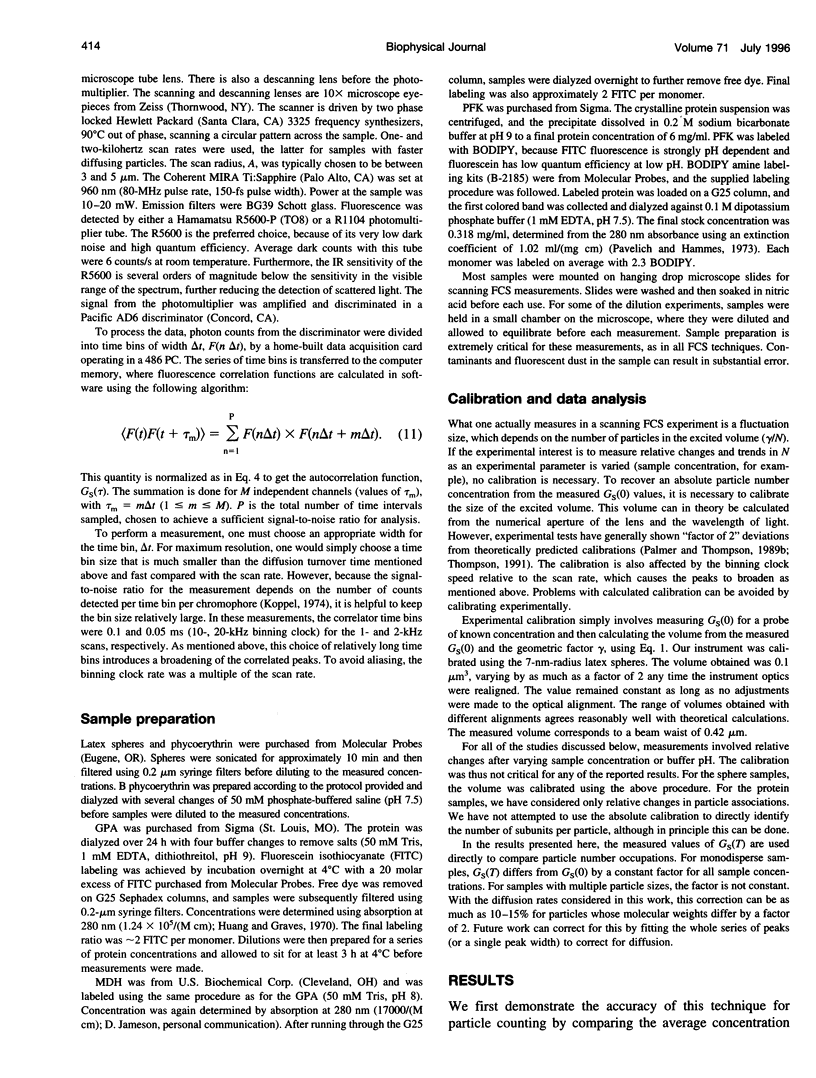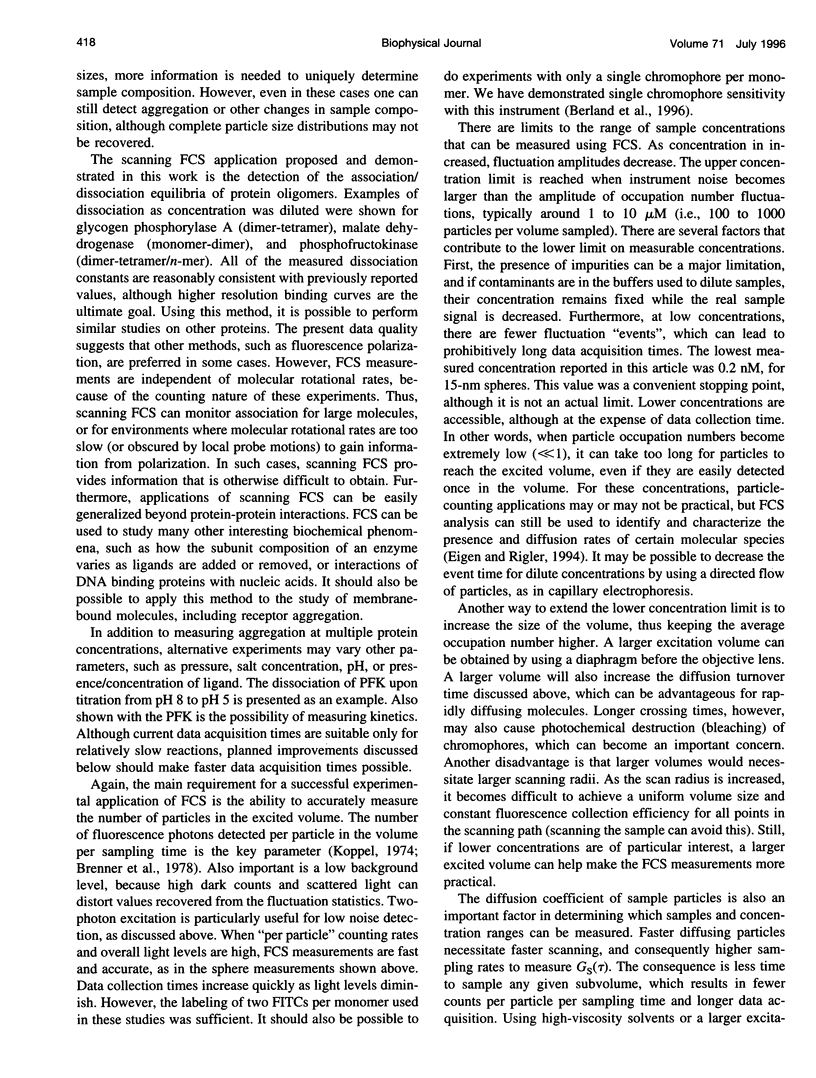Abstract
Scanning fluctuation correlation spectroscopy (FCS) is an experimental technique capable of measuring particle number concentrations by monitoring spontaneous equilibrium fluctuations in the local concentration of a fluorescent species in a small (femtoliter) subvolume of a sample. The method can be used to detect molecular aggregation for dilute, submicromolar samples by directly "counting particles". We introduce the application of two-photon excitation to scanning FCS and discuss its important advantages for this technique. We demonstrate the capability of measuring particle number concentrations in solution, first with dilute samples of monodisperse 7-nm and 15-nm radius latex spheres, and then with B phycoerythrin. The detection of multiple species in a single sample is shown, using mixtures containing both sphere sizes. The method is then applied to study protein aggregation in solution. We monitor the concentration-dependent association/ dissociation equilibrium for glycogen phosphorylase A and malate dehydrogenase. The measured dissociation constants, 430 nM and 144 nM respectively, are in good agreement with previously published values. In addition, oligomer dissociation induced by pH titration from pH 8 to pH 5.0 is detectable for the enyme phosphofructokinase. The possibility of measuring dissociation kinetics by scanning two-photon FCS is also demonstrated using phosphofructokinase.
Full text
PDF










Selected References
These references are in PubMed. This may not be the complete list of references from this article.
- Aaronson R. P., Frieden C. Rabbit muscle phosphofructokinase: studies on the polymerization. The behavior of the enzyme at pH 8, pH 6, and intermediate pH values. J Biol Chem. 1972 Dec 10;247(23):7502–7509. [PubMed] [Google Scholar]
- Berland K. M., So P. T., Gratton E. Two-photon fluorescence correlation spectroscopy: method and application to the intracellular environment. Biophys J. 1995 Feb;68(2):694–701. doi: 10.1016/S0006-3495(95)80230-4. [DOI] [PMC free article] [PubMed] [Google Scholar]
- Denk W., Strickler J. H., Webb W. W. Two-photon laser scanning fluorescence microscopy. Science. 1990 Apr 6;248(4951):73–76. doi: 10.1126/science.2321027. [DOI] [PubMed] [Google Scholar]
- Eigen M., Rigler R. Sorting single molecules: application to diagnostics and evolutionary biotechnology. Proc Natl Acad Sci U S A. 1994 Jun 21;91(13):5740–5747. doi: 10.1073/pnas.91.13.5740. [DOI] [PMC free article] [PubMed] [Google Scholar]
- Huang C. Y., Graves D. J. Correlation between subunit interactions and enzymatic activity of phosphorylase a. Method for determining equilibrium constants from initial rate measurements. Biochemistry. 1970 Feb 3;9(3):660–671. doi: 10.1021/bi00805a028. [DOI] [PubMed] [Google Scholar]
- Huang Z., Thompson N. L. Imaging fluorescence correlation spectroscopy: nonuniform IgE distributions on planar membranes. Biophys J. 1996 Apr;70(4):2001–2007. doi: 10.1016/S0006-3495(96)79766-7. [DOI] [PMC free article] [PubMed] [Google Scholar]
- Icenogle R. D., Elson E. L. Fluorescence correlation spectroscopy and photobleaching recovery of multiple binding reactions. I. Theory and FCS measurements. Biopolymers. 1983 Aug;22(8):1919–1948. doi: 10.1002/bip.360220808. [DOI] [PubMed] [Google Scholar]
- Koppel D. E., Morgan F., Cowan A. E., Carson J. H. Scanning concentration correlation spectroscopy using the confocal laser microscope. Biophys J. 1994 Feb;66(2 Pt 1):502–507. doi: 10.1016/s0006-3495(94)80801-x. [DOI] [PMC free article] [PubMed] [Google Scholar]
- Lad P. M., Hill D. E., Hammes G. G. Influence of allosteric ligands on the activity and aggregation of rabbit muscle phosphofructokinase. Biochemistry. 1973 Oct 23;12(22):4303–4309. doi: 10.1021/bi00746a001. [DOI] [PubMed] [Google Scholar]
- Magde D., Elson E. L., Webb W. W. Fluorescence correlation spectroscopy. II. An experimental realization. Biopolymers. 1974 Jan;13(1):29–61. doi: 10.1002/bip.1974.360130103. [DOI] [PubMed] [Google Scholar]
- Meyer T., Schindler H. Particle counting by fluorescence correlation spectroscopy. Simultaneous measurement of aggregation and diffusion of molecules in solutions and in membranes. Biophys J. 1988 Dec;54(6):983–993. doi: 10.1016/S0006-3495(88)83036-4. [DOI] [PMC free article] [PubMed] [Google Scholar]
- Palmer A. G., 3rd, Thompson N. L. Fluorescence correlation spectroscopy for detecting submicroscopic clusters of fluorescent molecules in membranes. Chem Phys Lipids. 1989 Jun;50(3-4):253–270. doi: 10.1016/0009-3084(89)90053-4. [DOI] [PubMed] [Google Scholar]
- Palmer A. G., 3rd, Thompson N. L. Molecular aggregation characterized by high order autocorrelation in fluorescence correlation spectroscopy. Biophys J. 1987 Aug;52(2):257–270. doi: 10.1016/S0006-3495(87)83213-7. [DOI] [PMC free article] [PubMed] [Google Scholar]
- Pavelich M. J., Hammes G. G. Aggregation of rabbit muscle phosphofructokinase. Biochemistry. 1973 Mar 27;12(7):1408–1414. doi: 10.1021/bi00731a022. [DOI] [PubMed] [Google Scholar]
- Petersen N. O. Diffusion and aggregation in biological membranes. Can J Biochem Cell Biol. 1984 Nov;62(11):1158–1166. doi: 10.1139/o84-149. [DOI] [PubMed] [Google Scholar]
- Petersen N. O., Höddelius P. L., Wiseman P. W., Seger O., Magnusson K. E. Quantitation of membrane receptor distributions by image correlation spectroscopy: concept and application. Biophys J. 1993 Sep;65(3):1135–1146. doi: 10.1016/S0006-3495(93)81173-1. [DOI] [PMC free article] [PubMed] [Google Scholar]
- Petersen N. O. Scanning fluorescence correlation spectroscopy. I. Theory and simulation of aggregation measurements. Biophys J. 1986 Apr;49(4):809–815. doi: 10.1016/S0006-3495(86)83709-2. [DOI] [PMC free article] [PubMed] [Google Scholar]
- Petersen N. O. Scanning fluorescence correlation spectroscopy. I. Theory and simulation of aggregation measurements. Biophys J. 1986 Apr;49(4):809–815. doi: 10.1016/S0006-3495(86)83709-2. [DOI] [PMC free article] [PubMed] [Google Scholar]
- Qian H., Elson E. L. Distribution of molecular aggregation by analysis of fluctuation moments. Proc Natl Acad Sci U S A. 1990 Jul;87(14):5479–5483. doi: 10.1073/pnas.87.14.5479. [DOI] [PMC free article] [PubMed] [Google Scholar]
- Qian H., Elson E. L. On the analysis of high order moments of fluorescence fluctuations. Biophys J. 1990 Feb;57(2):375–380. doi: 10.1016/S0006-3495(90)82539-X. [DOI] [PMC free article] [PubMed] [Google Scholar]
- Ruan K., Weber G. Physical heterogeneity of muscle glycogen phosphorylase revealed by hydrostatic pressure dissociation. Biochemistry. 1993 Jun 22;32(24):6295–6301. doi: 10.1021/bi00075a025. [DOI] [PubMed] [Google Scholar]
- Shore J. D., Chakrabarti S. K. Subunit dissociation of mitochondrial malate dehydrogenase. Biochemistry. 1976 Feb 24;15(4):875–879. doi: 10.1021/bi00649a023. [DOI] [PubMed] [Google Scholar]
- St-Pierre P. R., Petersen N. O. Relative ligand binding to small or large aggregates measured by scanning correlation spectroscopy. Biophys J. 1990 Aug;58(2):503–511. doi: 10.1016/S0006-3495(90)82395-X. [DOI] [PMC free article] [PubMed] [Google Scholar]
- WANG J. H., GRAVES D. J. THE RELATIONSHIP OF THE DISSOCIATION TO THE CATALYTIC ACTIVITY OF GLYCOGEN PHOSPHORYLASE A. Biochemistry. 1964 Oct;3:1437–1445. doi: 10.1021/bi00898a008. [DOI] [PubMed] [Google Scholar]
- Weissman M., Schindler H., Feher G. Determination of molecular weights by fluctuation spectroscopy: application to DNA. Proc Natl Acad Sci U S A. 1976 Aug;73(8):2776–2780. doi: 10.1073/pnas.73.8.2776. [DOI] [PMC free article] [PubMed] [Google Scholar]


